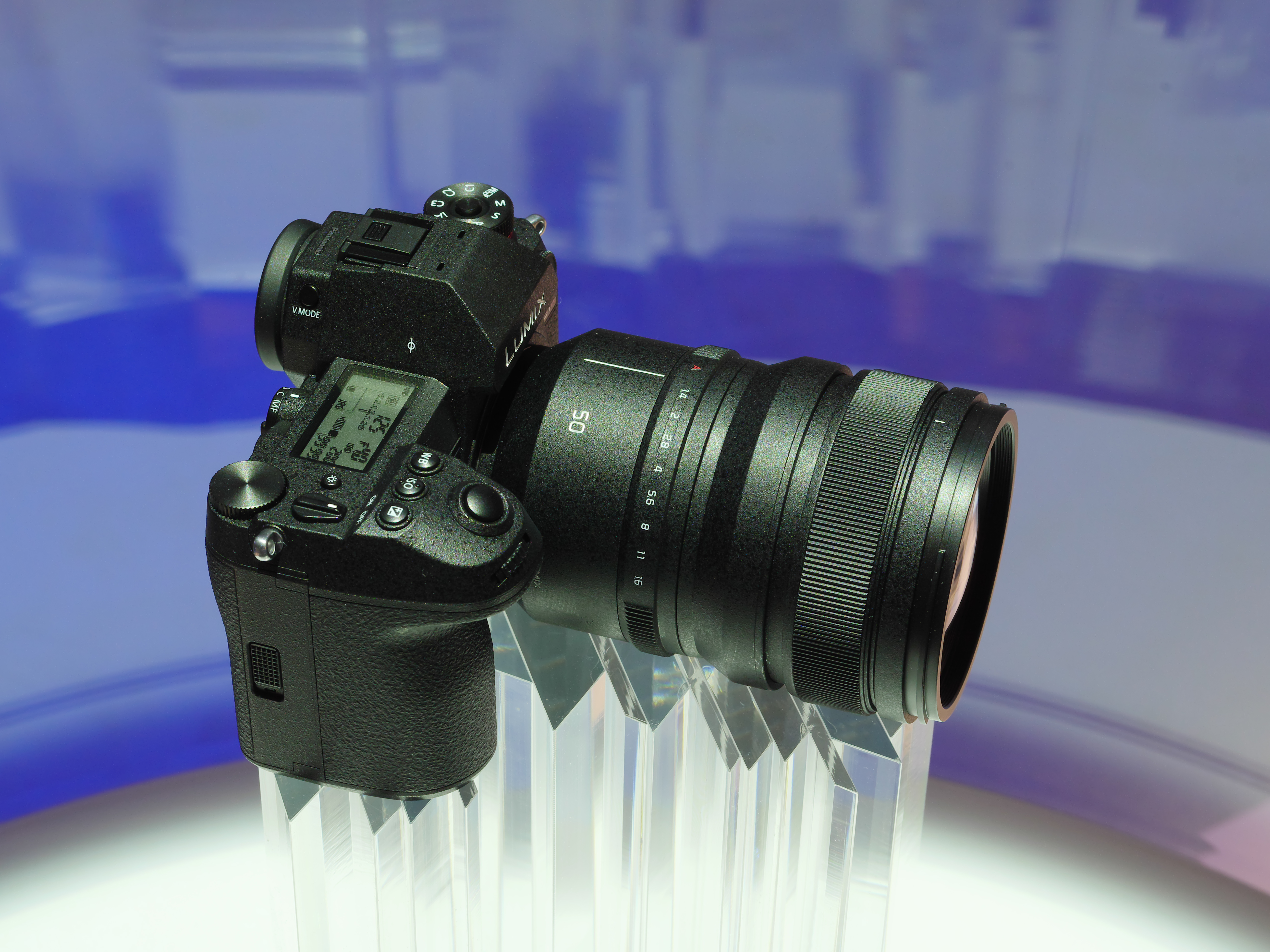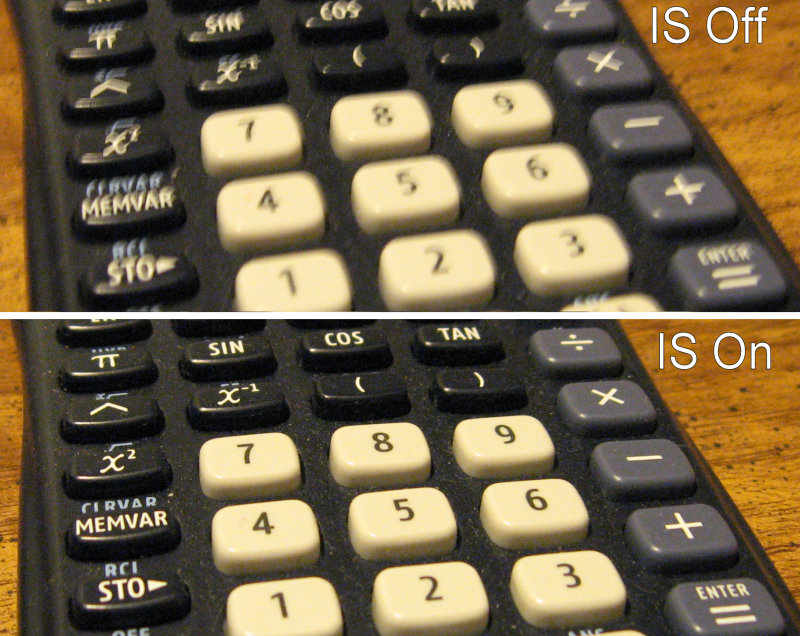|
Panasonic DMC-L1
The Lumix DMC-L1 is Panasonic's first DSLR camera, and was announced in February 2006. This camera adheres to the Four Thirds System lens mount standard, making it the first non-Olympus Four Thirds camera, and thus confirming that the Four Thirds System is a semi-open standard such that compatible camera bodies can be built by different companies. The Lumix DMC-L1, together with the Olympus E-330 (with which it shares some technology), were the first ILCs that featured live view, a capability later copied by other manufacturers. Live view makes it possible to preview the image on the LCD screen while composing the picture, and is particularly useful for high- and low-angled shots when it is uncomfortable or not feasible for the user to bring the eye to the viewfinder. The camera was introduced with a new Leica D Vario-Elmarit 14–50mm f/2.8–3.5 lens (a 28-100mm 35mm equivalent), the first Leica lens for the Four Thirds System, and the first Four Thirds lens with image stabiliz ... [...More Info...] [...Related Items...] OR: [Wikipedia] [Google] [Baidu] |
Panasonic
is a Japanese multinational electronics manufacturer, headquartered in Kadoma, Osaka, Kadoma, Japan. It was founded in 1918 as in Fukushima-ku, Osaka, Fukushima by Kōnosuke Matsushita. The company was incorporated in 1935 and renamed and changed its name to in 2008. In 2022, it reorganized as a holding company and adopted its current name. In addition to consumer electronics, for which it was the world’s largest manufacturer in the late 20th century, Panasonic produces a wide range of products and services, including Rechargeable battery, rechargeable batteries, automotive and avionic systems, industrial equipment, as well as home renovation and construction. The company is listed on the Tokyo Stock Exchange and is a constituent of the Nikkei 225 and TOPIX, TOPIX 100 indices, with a secondary listing on the Nagoya Stock Exchange. Corporate name From 1925 to October 1, 2008, the company's corporate name was "Matsushita Electric Industrial Co." (MEI). On January 10, 2008, ... [...More Info...] [...Related Items...] OR: [Wikipedia] [Google] [Baidu] |
Olympus Corporation
is a Japanese manufacturer of optics and reprography products, headquartered in Hachioji, Tokyo. Olympus was established in 1919, initially specializing in microscopes and thermometers, and later in imaging. Olympus holds roughly a 70 percent share of the global endoscope market, estimated to be worth approximately US$2.5 billion. It was formerly also a maker of cameras, camera lens, camera lenses and dictaphones, until it divested this part to OM Digital Solutions in 2020. In 2011, Olympus scandal, Olympus attracted worldwide media scrutiny when it fired its CEO Michael Christopher Woodford for whistleblowing, and the matter snowball effect, snowballed into a corporate corruption investigation with multiple arrests. In 2016, it paid million (equivalent to $million in ) in fines associated with its illegal, long running, Kickback (bribery), kickback scheme. Products Cameras and audio In 1936, Olympus introduced its first camera, the Semi-Olympus I, fitted with the first Z ... [...More Info...] [...Related Items...] OR: [Wikipedia] [Google] [Baidu] |
Panasonic Lumix Cameras
is a Japanese multinational electronics manufacturer, headquartered in Kadoma, Japan. It was founded in 1918 as in Fukushima by Kōnosuke Matsushita. The company was incorporated in 1935 and renamed and changed its name to in 2008. In 2022, it reorganized as a holding company and adopted its current name. In addition to consumer electronics, for which it was the world’s largest manufacturer in the late 20th century, Panasonic produces a wide range of products and services, including rechargeable batteries, automotive and avionic systems, industrial equipment, as well as home renovation and construction. The company is listed on the Tokyo Stock Exchange and is a constituent of the Nikkei 225 and TOPIX 100 indices, with a secondary listing on the Nagoya Stock Exchange. Corporate name From 1925 to October 1, 2008, the company's corporate name was "Matsushita Electric Industrial Co." (MEI). On January 10, 2008, the company announced that it would change its name to "Panaso ... [...More Info...] [...Related Items...] OR: [Wikipedia] [Google] [Baidu] |
Zuiko
Zuiko ( or ) is a brand of optical lenses made by Olympus Corporation that was used up to and into the Four Thirds system era. The name Zuiko () means 'Holy Light', using a character from the Mizuho Optic Research Laboratory (), where the lens was developed, and a character from Takachiho Corporation (), which would eventually become the Olympus Corporation. With the introduction of the Micro Four Thirds system in 2008, new lenses for that system started to be branded as ''M.Zuiko Digital''. Optical formula nomenclature For lenses manufactured until approximately 1972, the number of optical elements of the lens, angle of view, and diaphragm operation could be distinguished by the markings engraved on the lens. The engraving dropped the number of elements with the advent of multicoating, which occurred during the production of OM system lenses. Ace, Pen-F, FTL, and early OM system lenses carry the letter prefix denoting the number of optical elements. Later OM system lenses (ge ... [...More Info...] [...Related Items...] OR: [Wikipedia] [Google] [Baidu] |
Micro Four-Thirds
The is a standard released by Olympus Imaging Corporation and Panasonic in 2008, for the design and development of mirrorless interchangeable lens digital cameras, camcorders and lenses. Camera bodies are available from Blackmagic, DJI, JVC, Kodak, Olympus, OM System, Panasonic, Sharp, Logitech Mevo and Xiaomi. MFT lenses are produced by Cosina Voigtländer, Kowa, Kodak, Mitakon, Olympus, Panasonic, Samyang, Sharp, Sigma, SLR Magic, Tamron, Tokina, TTArtisan, Veydra, Xiaomi, Laowa, Yongnuo, Zonlai, Lensbaby, Venus Optics and 7artisans amongst others. The specifications of the MFT system inherit the original sensor format of the Four Thirds system, designed for DSLRs. However, unlike Four Thirds, the MFT system design specification does not require lens telecentricity, a parameter which accommodated for the inaccurate sensitivity to off-angle light due to the geometry of the photodetectors of contemporary image sensors. Later improvements in manufacturing capabilities enab ... [...More Info...] [...Related Items...] OR: [Wikipedia] [Google] [Baidu] |
Four-Thirds
The Four Thirds System is a standard created by Olympus and Eastman Kodak for digital single-lens reflex camera (DSLR) design and development. Four Thirds refers to both the size of the image sensor (4/3") as well as the aspect ratio (4:3). The Olympus E-1 was the first Four Thirds DSLR, announced and released in 2003. In 2008, Olympus and Panasonic began publicizing the Micro Four Thirds system, a mirrorless camera system which used the same sensor size; by eliminating the reflex mirror, the Micro Four Thirds cameras were significantly smaller than the Four Thirds cameras. The first Micro Four Thirds cameras were released in 2009 and the final Four Thirds cameras were released in 2010; by that time, approximately 15 Four Thirds camera models had been released by Olympus and Panasonic in total. The system provides a standard that permits interoperability of digital cameras and lenses made by different manufacturers. Proponents describe it as an open standard, but companies may ... [...More Info...] [...Related Items...] OR: [Wikipedia] [Google] [Baidu] |
Panasonic Lumix DMC-L10
The Lumix DMC-L10 is Panasonic's second digital single-lens reflex camera (DSLR), a follow-up to the previous Lumix DMC-L1 model. It was announced in August 2007, and, like the Lumix DMC-L1, this model uses the Four Thirds System lens mount standard and contains some basic parts provided by Olympus. (Its siblings are the Olympus E-410 and E-510, all three cameras sharing some of the same basic internals.) A new kit lens bearing the Leica label was introduced with this camera, the Leica D Vario-Elmar 14–50mm/ F3.8–5.6/ASPH MEGA OIS. As the name implies, it features optical image stabilization. Panasonic also announced a new Leica-labeled 14–150 mm superzoom lens for the Four Thirds standard, also with optical image stabilization. Features The Lumix DMC-L10 featured improvements to the live view facility, permitting the image to be previewed on the LCD screen when composing the shot. The Lumix DMC-L10 has a second-generation live view function that allows autofocus wi ... [...More Info...] [...Related Items...] OR: [Wikipedia] [Google] [Baidu] |
Leica Digilux 3
The Digilux 3 is a digital single-lens reflex camera introduced by Leica on 14 September 2006. The Digilux 3 and the Panasonic Lumix DMC-L1 are similar specification cameras, using the Four Thirds standard lens mount and featuring a 7.5 Megapixels live view N-MOS sensor, but the Digilux 3 has modified firmware including DNG output. Both the Panasonic and Digilux 3 cameras come standard with the same interchangeable Leica Elmarit 14–50 mm f/2.8–3.5 optically image-stabilized zoom lens. The Leica D system includes also the Leica Summilux 25 mm f/1.4 lens. The two cameras share several unique features among dSLRs. One is the presence of film-camera type controls for optional control of both aperture and shutter speed. Reviews have noted the intuitive "feel" of the cameras. Another is the built-in dual-position flash. With an initial actuation of the flash button, the flash pops up to a bounce-flash position, giving a more diffuse flash that is preferred by some ph ... [...More Info...] [...Related Items...] OR: [Wikipedia] [Google] [Baidu] |
Flash (photography)
A flash is a device used in photography that produces a brief burst of light (lasting around of a second) at a color temperature of about 5500 K to help illuminate a scene. The main purpose of a flash is to illuminate a dark scene. Other uses are capturing quickly moving objects or changing the quality of light. ''Flash'' refers either to the flash of light itself or to the electronic flash unit discharging the light. Most current flash units are electronic, having evolved from single-use flashbulbs and flammable powders. Modern cameras often activate flash units automatically. Flash units are commonly built directly into a camera. Some cameras allow separate flash units to be mounted via a standardized accessory mount bracket (a '' hot shoe''). In professional studio equipment, flashes may be large, standalone units, or studio strobes, powered by special battery packs or connected to mains power. They are either synchronized with the camera using a flash synchronization ... [...More Info...] [...Related Items...] OR: [Wikipedia] [Google] [Baidu] |
Image Stabilization
Image stabilization (IS) is a family of techniques that reduce motion blur, blurring associated with the motion of a camera or other imaging device during exposure (photography), exposure. Generally, it compensates for panning (camera), pan and tilt (camera), tilt (angular movement, equivalent to aircraft principal axes, yaw and pitch) of the imaging device, though electronic image stabilization can also compensate for rotation about the optical axis (aircraft principal axes, roll). It is mainly used in high-end image-stabilized binoculars, digital camera, still and video camera, video cameras, astronomical telescopes, and also smartphones. With still cameras, camera shake is a particular problem at slow shutter speeds or with long focal length lenses (telephoto lens, telephoto or zoom lens, zoom). With video cameras, camera shake causes visible frame-to-frame jitter (optics), jitter in the recorded video. In astronomy, the problem of lens shake is added to Astronomical seeing, ... [...More Info...] [...Related Items...] OR: [Wikipedia] [Google] [Baidu] |
Leica D Vario-Elmarit 14–50mm F/2 , a former settlement in Ethiopia
{{disambiguation ...
Leica may refer to: Companies * Ernst Leitz GmbH, later divided into: ** Leica Biosystems GmbH, a cancer diagnostics company ** Leica Camera AG, a German camera and optics manufacturer ** Leica Geosystems AG, a Swiss manufacturer of surveying and geomatics equipment ** Leica Microsystems GmbH, a German manufacturer of microscopes and other precision optics Other uses * "Leica", a song from the album ''Akeldama'' by Faceless * Leica (river), Romania * Leica reel, a type of animatic production method for animation See also * Laika (other) * Lieka Lieka or Liekà was a former settlement in 19th and early 20th century Ethiopia, a major market town in the Oromo region southwest of Shoa. It was located on the Bilo plain, southwest of Sokota and retained a hereditary Oromo ruler upon its inte ... [...More Info...] [...Related Items...] OR: [Wikipedia] [Google] [Baidu] |





